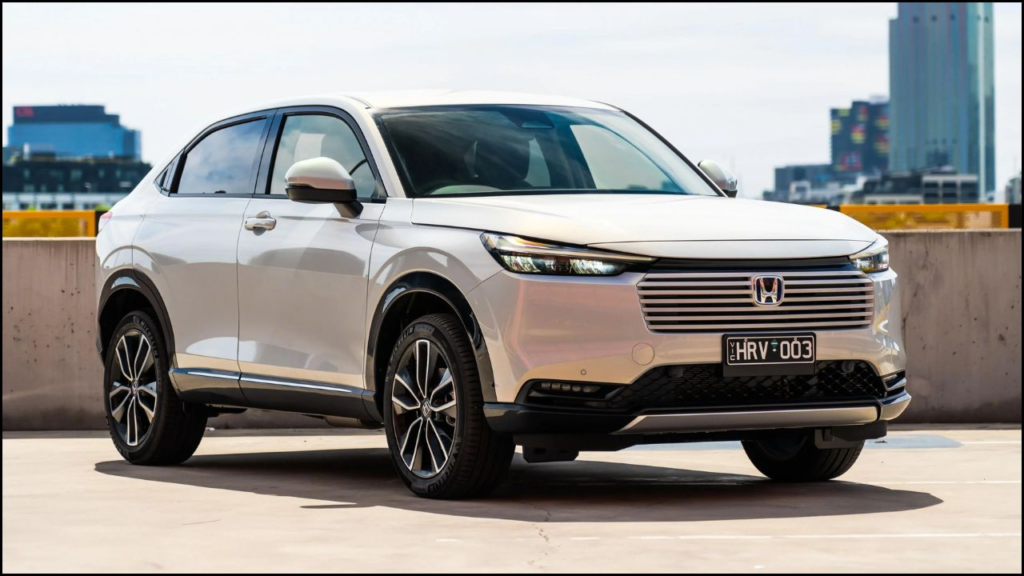
Honda has unveiled the 2025 HR-V SUV, highlighting hybrid efficiency and premium features in its global line-up. The compact SUV, one of Honda’s most important models worldwide, targets growing demand for fuel-efficient, safety-focused vehicles across Europe, North America, and parts of Asia.
Hybrid Efficiency at the Centre
The 2025 Honda HR-V builds on Honda’s electrification strategy. In Europe and the United Kingdom, the HR-V is sold exclusively as a hybrid using Honda’s e:HEV system. This combines a 1.5-litre petrol engine with two electric motors, enabling the vehicle to run short distances in electric-only mode.
According to Honda’s official release, the hybrid model offers “the efficiency of an electric drive with the flexibility of a petrol engine.” Independent estimates suggest combined fuel economy of around 18–20 km/l in hybrid markets.
Petrol Options Remain in Some Markets
In the United States, Honda continues to sell the HR-V with a 2.0-litre four-cylinder petrol engine producing 158 horsepower. Figures from Honda Motor America place the combined fuel economy at 27 miles per gallon.
For consumers in Japan and Southeast Asia, both petrol and hybrid options are available. In India, however, the HR-V has not been launched. Instead, Honda markets the Elevate SUV, citing higher cost barriers for importing or localising the HR-V. Industry analysts estimate that if introduced, the HR-V would fall in the ₹10–15 lakh range, directly competing with Hyundai Creta, Kia Seltos, and Maruti Suzuki Grand Vitara.
New Honda HR-V 2025 SUV Design and Styling
Honda has refreshed the exterior styling of the 2025 HR-V to appeal to younger buyers. The SUV now features a bolder grille, slimmer LED headlights, and coupe-inspired rooflines. The rear design incorporates sharper taillights and a more sculpted bumper, aimed at giving the vehicle a sportier stance.
Inside, the HR-V includes soft-touch dashboard materials, a redesigned centre console, and improved seating ergonomics. Higher trims come with leather upholstery, ambient lighting, and dual-zone climate control.
New Honda HR-V 2025 SUV Technology and Connectivity
Technology plays a key role in the 2025 HR-V. The model introduces a 9-inch infotainment touchscreen in select markets, with support for Apple CarPlay and Android Auto. Higher trims offer wireless smartphone integration and a digital instrument cluster.
Honda has also expanded connected car features, enabling drivers to remotely lock, unlock, or start the vehicle through a smartphone app in markets where connectivity services are available.
Safety Remains Standard
The 2025 HR-V comes equipped with Honda SENSING®, the company’s advanced driver-assistance package. This includes adaptive cruise control, lane-keeping assist, traffic sign recognition, and collision mitigation braking.
“The move to standardise advanced driver-assist features reflects consumer demand for safety and regulatory changes across Europe and North America,” said Dr. Kenji Matsumoto, automotive analyst at the Japan Automobile Research Institute.
Environmental Impact and Honda’s Roadmap
Hybrid SUVs like the HR-V play a transitional role in Honda’s global electrification strategy. The company aims to achieve carbon neutrality for all products and corporate activities by 2050.
According to Honda’s sustainability report, the hybrid HR-V emits lower CO₂ compared to equivalent petrol vehicles, making it a compliance-friendly choice under Europe’s tightening fleet emission rules. Analysts argue that such models will help Honda bridge the gap until its planned global rollout of battery electric vehicles (BEVs) accelerates after 2026.
Consumer Reception and Early Reviews
Early reviews from U.S. and European automotive journalists highlight the HR-V’s spacious interior and comfortable ride quality. Critics, however, note that the petrol engine variant lacks power compared to some rivals.
In the UK, Auto Express magazine described the HR-V hybrid as “a balanced family SUV with strong fuel economy and reassuring safety features.” U.S. reviewers were more reserved, praising practicality but questioning performance at highway speeds.
Competitor Landscape
The HR-V competes in one of the most competitive SUV segments. In Europe, it faces Toyota’s Yaris Cross Hybrid and Hyundai’s Kona Hybrid, both of which have already established strong sales.
In India, if introduced, the HR-V would directly compete with the Hyundai Creta, Kia Seltos, Maruti Suzuki Grand Vitara, and Toyota Urban Cruiser Hyryder. These models dominate the mid-sized SUV market, leaving limited room for newcomers without aggressive pricing.
“Success in India would require Honda to localise production and offer competitive pricing, which is challenging given the HR-V’s global positioning,” explained Rajiv Mehta, senior auto editor at The Economic Times.
Market-Specific Strategy
Honda’s approach to the HR-V differs by region. In Europe, the hybrid-only strategy reflects regulatory necessity. In North America, where fuel prices are lower, petrol models remain viable. In Asia, Honda employs a mixed strategy, balancing affordability with demand for hybrids in urban areas.
India remains absent from the HR-V plan. Honda officials have not confirmed any timeline for introduction, citing the focus on the Elevate, City, and Amaze models.
Future Outlook
Industry experts believe the HR-V could still be introduced in India if hybrid adoption accelerates and costs decline. Global trends suggest compact SUVs will remain popular, with hybrids serving as a practical step before full electrification.
“The HR-V is central to Honda’s global SUV portfolio,” said Anil Sharma, senior analyst at Nomura Research Institute. “Its success in balancing cost, technology, and sustainability will shape how Honda competes in emerging and mature markets alike.”
Conclusion
The 2025 Honda HR-V signals the company’s effort to strengthen its compact SUV segment with hybrid efficiency, premium features, and modern safety technology. Its dual strategy—hybrids in Europe and petrol models in the U.S.—illustrates Honda’s adaptation to regional realities. Whether the HR-V will enter India remains uncertain, but its global positioning reinforces Honda’s broader ambition to shift towards low-emission mobility while maintaining mass-market appeal.

















